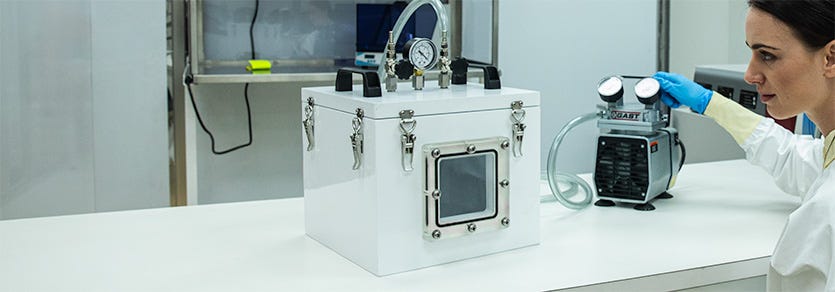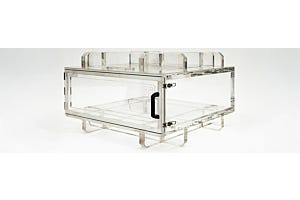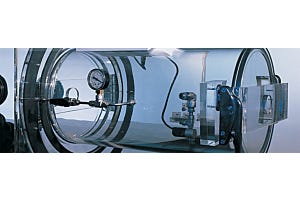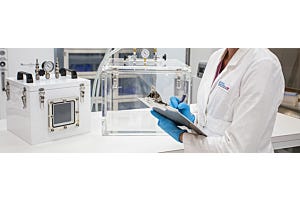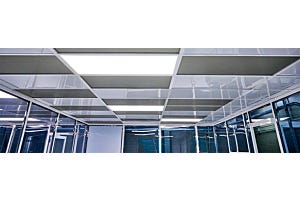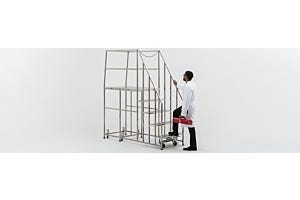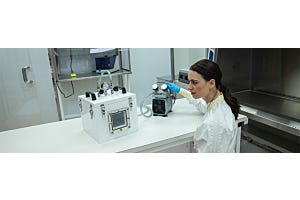This guide evaluates aluminum and stainless steel vacuum chamber characteristics, components, and performance. Compared to plastic vacuum chambers, metal vacuum chambers are favorable for applications requiring maintained internal temperatures, heat/cold cycling, extreme temperature ranges, and low outgassing rates. Although they require a larger upfront expense, stainless steel vacuum chambers are cost-effective in the long run due to their durability, extended lifespan, and minimal maintenance. By understanding the materials, construction techniques, and design methodologies, you can make an informed decision and ensure the success of your vacuum processes.
- Vacuum Chamber for Leak Testing, Vacuum Drying, Degassing
- Vacuum Chambers for Stress and Pressure Testing
- Vacuum Chambers for Atmospheric Simulation and Testing
Aluminum and Stainless Steel Vacuum Chamber Material Performance

Stainless steel and aluminum vacuum chamber materials offer several favorable attributes compared to plastic chamber alternatives. When choosing between these materials:
If you're deciding between a stainless steel versus an aluminum vacuum chamber, here are some important distinctions to consider.
Vacuum Materials and Outgassing Rates
Outgassing Rates: Outgassing refers to the release of gas trapped within materials, which is amplified by exposure to increasingly lower pressures. Outgassing can contaminate the vacuum environment, and impact performance factors such as pressure stability and pump efficiency.
Stainless steel generally has lower outgassing rates compared to aluminum, making it suitable for low and ultra-high vacuum (UHV) applications. Lower outgassing rates are essential for high and ultra-high vacuum applications to prevent pressure variability, reduce pump loads, and ensure measurement accuracy. Applications such as spectroscopic analyses, surface composition assessments, and thin film thickness evaluations are more susceptible to inaccuracies caused by contaminants and pressure fluctuations.
For a comparison of outgassing rates by vacuum chamber material, the following values indicate the amount of gas released from a material's surface in a vacuum environment, expressed in torr liters per second per linear centimeter:
| Material | Outgassing Rate (torr liter/sec/linear cm) |
|---|---|
| Stainless Steel | 6 × 10-9 |
| Aluminum | 7 × 10-9 |
| Mild Steel | 5 × 10-6 |
| Brass | 4 × 10-6 |
| High-Density Ceramic | 3 × 10-9 |
| Pyrex | 8 × 10-9 |
| Viton (Unbaked) | 8 × 10-7 |
| Viton (Baked) | 4 × 10-8 |
Source: Phil Danielson | R&D Magazine, April 2003
Extended Considerations for Vacuum Chamber Performance and Cost

Permeability: Aluminum is more susceptible to surface imperfections and permeability issues, which can lead to higher outgassing rates. However, this can be mitigated to some extent through surface treatments such as anodizing or using diffusion barriers.
Chemical Compatibility: Both aluminum and stainless steel offer excellent resistance to various chemicals, but stainless steel is preferred for environments with harsh chemicals or corrosive substances. Aluminum's reactivity with certain chemicals limits its use in environments where corrosive gases are present.
Thermal Conductivity is important in processes involving significant thermal loads. Aluminum has higher thermal conductivity than stainless steel, which can be advantageous in applications requiring efficient heat dissipation or temperature cycling. Stainless steel has the advantage of slower heat dissipation and a higher temperature range, making it favorable for tasks that require extreme temperature cycles or prolonged exposure to high temperatures over sustained periods.
Weight and Machinability: Known for its high strength and hardness, stainless steel is more challenging to machine than aluminum. It requires more force and power, leading to increased tool wear and the need for more robust equipment. Aluminum is lighter and easier to machine than stainless steel, which can be beneficial for the customization of feedthrough ports, valves, and metering gauges at lower manufacturing costs.
Leak Tight Vacuum Welding: Extends design freedom and custom fabrication capabilities for aluminum and stainless steel materials. Both materials can present challenges and are highly dependent on the specific welding techniques and conditions. Aluminum welds require more thoughtful approaches to cleanliness, joint design, and welding techniques. Vacuum-tight aluminum welds are more difficult to achieve, as the material is more prone to uneven cooling, surface oxidation, and the development of leak paths if the cover material is removed. Therefore, when custom fabrication requires leak-tight welds, stainless steel is a more forgiving material.
Cost: While aluminum is typically more cost-effective, stainless steel offers superior durability and lower maintenance over time. Although stainless steel vacuum chambers come with a higher upfront cost, their increased durability and chemical resilience can lead to considerable cost savings and fewer maintenance burdens in the long run.
Vacuum Chamber Shape, Geometry, and Deflection
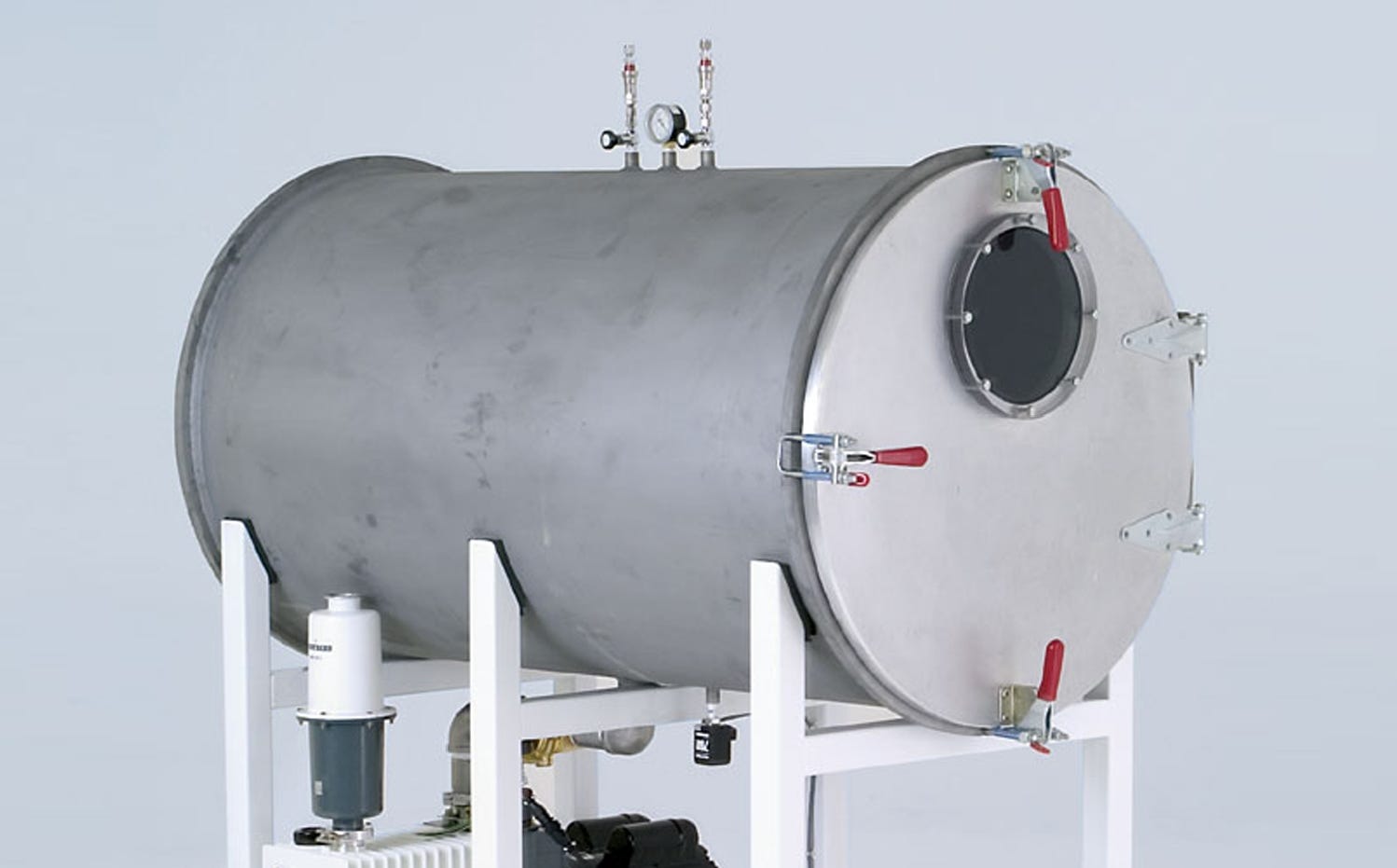
Geometry and chamber envelope are key considerations for any vacuum chamber purchase. The choice between a spherical, square, or rectangular chamber is largely determined by the size, shape, and access preference of the end user. Terra employs several design strategies to reduce and prevent these issues, such as inherently strong shapes that minimize deflections and robust seals supported by high-quality hardware.
Deflections refer to deformations or displacements of the chamber structure, which occur when the exterior structure is subjected to external atmospheric pressure. This interaction can lead to several failures, including cracking, leakage, or complete collapse.
Spherical Vacuum Chambers benefit from a uniform and even distribution of pressure on all sides and therefore demonstrate the greatest stability and strength at low pressures. This is why you'll find that most deep-sea vessels and submarines maintain a cylindrical or sphere shape.
Spherical chambers are known for their efficiency in minimizing material use, achieving uniform vacuum conditions, and presenting ideal geometry for a vacuum chamber system with minimal deflections. However, several factors can make sphere-shaped chambers less practical.
Spherical chambers offer the least amount of internal chamber space and are increasingly expensive to manufacture at larger sizes due to their unique geometry. Spherical chambers require precise and complex geometries that can be challenging and costly to produce with uniform thickness. For many industrial or high-demand applications, alternative geometries and non-plastic materials are often more practical and cost-effective.
Cylindrical Vacuum Chambers are favorable for general-purpose applications due to their high strength and uniform pressure distribution. The cylindrical shape minimizes stress points, making it ideal for processes requiring consistent vacuum levels. However, the downside of cylindrical designs is that they have the least amount of internal chamber space, and access doors may present limitations.

Square Box Vacuum Chambers: Frequently used in laboratory settings, box chambers offer easy access, configuration flexibility, and the lowest cost for manufacturing. Square or rectangular vacuum chambers are practical for experiments that require frequent access to the chamber's interior and support for flat-profile items such as circuit boards, documents, textiles, and bulk arrays. Flat walls minimize the distortion of light, making it easier to see true shapes inside the chamber without opening the door.
Terra's box-shaped aluminum and 304 stainless steel vacuum chambers have hinged doors that allow the vacuum chamber to be situated with the door facing upward or forward, depending on your application. Positioning the chamber with the door facing upward can help safely contain liquid spills or corrosive chemicals. Positioning the chamber with the door facing forward allows the door to easily swing open for faster batch processing.
Vacuum Chamber Components
Terra offers plastic and metal vacuum chamber models with many customizable accessories customizable with various meters, pumps, ports, feedthroughs, and more.
► Stainless Steel Vacuum Chamber Configurator
► Aluminum Vacuum Chamber Configurator
Main Chamber Body: Constructed from high-quality aluminum or stainless steel, the main body provides structural integrity and minimizes outgassing. The choice of material impacts the chamber's performance and durability concerning chemical compatibility, moisture resilience, rigidity, and a wide temperature range.
Doors and Ports are critical for accessing the chamber and introducing materials or instruments. Equally, doors and ports must be integrated without compromising major structural items. Flat surfaces generate the largest deflections and are the most susceptible to buckling, therefore combining a sealing flange with a dished head or a curved plate is a common way to make doors stronger under vacuum.
Vacuum Control Modules are critical for maintaining precise vacuum levels, especially in applications that require continuous and stable vacuum conditions. Vac controllers regulate pump operation, ensuring that the vacuum pressure in a remote chamber remains consistent at a preset level of up to 800 torr. This is particularly vital for testing and processing tasks where the materials or processes involved demand sustained exposure to specific vacuum conditions.
Vacuum Gauges allow the measurement and display of internal vacuum levels so that vacuum pressure can be monitored from the outside. Terra's standard models display 0-30 inches of mercury (Hg) for low vacuum models, but we often provide custom gauge sets that are tailored to specific customer requirements.
Automatic RB® Safety Valves: continuously release excess internal gas to maintain a safe positive pressure inside glove boxes and use a variable release mechanism to automatically discharge sudden surges of incoming gas. It also acts as a check valve to protect against accidental negative pressure, ensuring consistent internal conditions.
Metering Valves: allow precise control of the vacuum environment, including pressure control, venting, and gas backfilling. High-quality valves and controllers are crucial for maintaining and monitoring consistent vacuum conditions. All Terra Universal vacuum chambers include two metering valves: one for applying vacuum and another for backfilling with nitrogen or other gases, and vacuum gauges with pressure readings from 0 to 30" Hg.
Terra's Mini Ball Valves (¼") allow for manual vacuum control during the initiation or cessation of vacuum pressure. Dual valves allow for the purging of the chamber air before the vacuum is applied, which is important for applications that require low contamination levels and precise gas mixtures. Afterward, the valve can be opened to allow air or other gases to re-enter the chamber in a controlled manner, preventing rapid pressure changes that could damage equipment or compromise safety.
Viewing Windows: Sealed, 1”-thick acrylic windows are deployed on Terra's aluminum and stainless steel models, which afford a view of the chamber’s contents. Optional tempered glass viewing windows are available for improved visibility and broader enablement of optical testing equipment, cameras, or exterior magnification devices.
Universal Vacuum Chamber Stands ensure support and stability for equipment of various sizes. Adjustable telescoping members allow for a precise fit. Terra offers a wide selection of stainless and powder-coated steel stands to ensure appropriate levels of cleanliness, stability, and durability for your application.
Vacuum Chamber Pumps and Vacuum Control Modules

Vacuum Pumps are essential for achieving and maintaining the desired vacuum level. Selection requirements are typically based on the required pressure range and application sensitivities. Terra can help you determine which pump is most appropriate for your application needs, whether it is a rotary vane, diaphragm, belt-driven, or dry roughing system.
Welch Rotary Vane Vacuum Pumps feature non-wearing parts to eliminate particulate contamination and prevent hydrocarbon back-streaming. This design significantly reduces maintenance costs, requiring complete overhauls only every 20,000 hours. These pumps are designed for non-corrosive applications involving analytical instruments, research and development, and or contamination-sensitive processes. Sub-D connectors allow remote control capabilities and broad compatibility for integration into most systems.
Welch WOB-L Pumps support standard-duty uses, such as aspiration, vacuum chucking, multi-funnel filtration manifolds, gas sampling, vacuum drying, and automation technology. It is not intended for corrosive environments, where corrosion resistance would be necessary.
Diaphragm Vacuum Pumps: Oil-free, diaphragm pumps for rough and medium-high vacuum; ideal for research and scientific applications. Chemically resistant diaphragm pump models MPC are used with aggressive solvents and acid vapors.
Belt-Driven DuoSeal Vacuum Pumps: Light, compact, chemical-resistant with high vacuum performance: ideal for labs.
Dry Roughing Vacuum Pumps: Oil-free, quiet, and economical for a wide range of laboratory and cleanroom applications such as general lab use, wire and die bonders, scribers, breakers, dicing saws, and most other microelectronics manufacturing and testing equipment. Incoming air never goes near the motor and the cooler air temperature adds to overall efficiency and service life.
Vacuum Chamber Control Modules
Vacuum Control Modules are engineered for precise management of vacuum processes across research and testing applications. Computer-aided controls facilitate accurate adjustment of vacuum levels, optimizing conditions for processes such as freeze-drying, distillation, and vacuum ovens.
Terra's eVAC™ Altitude Simulation Control Modules integrate seamlessly with sensors to continuously monitor the vacuum environment, allowing real-time adjustments to the vacuum pump's operation. This capability promotes pump cycle efficiency for reduced wear and tear and precisely maintains ideal vacuum conditions. Advanced models offer programmable vacuum cycles, data logging, and remote monitoring capabilities. Programming features allowed for advanced simulations in aerospace or vessel testing to replicate realistic flight path conditions, such as gradual increases and decreases of pressure throughout a flight path.
Continue to: How to Automatically Control Vacuum in Vacuum Test Chambers
Vacuum Chamber Gasket and Seal Design

Gaskets and Seals: Made from materials like elastomers or metals, gaskets and seals ensure airtight connections between components. The selection of gasket material depends mostly on the vacuum level, temperature, and chemical compatibility requirements. Additional considerations include outgassing requirements, preference for permanent or demountable seals, and in some cases, consideration for radiation exposure.
Vacuum O-Ring & Gasket Materials: Doors and ports should be designed with robust seals for vacuum integrity. The most common configuration for demountable vacuum seals is a flange or door joint sealed with an elastomer gasket. Elastomer o-rings (flat gaskets) are also common and are most effective when laid within an o-ring groove. Gaskets and o-rings must provide an adequate seal, but also that the fitment is not too tight, which can make unsealing and opening the chamber increasingly difficult.
- Terra's stainless steel vacuum chambers feature a heat-resistant vacuum oven silicone gasket that ensures an air-tight seal when the door is latched shut.
- Viton®-A (fluorocarbon) is the most commonly utilized gasket material due to its excellent chemical resistance, high-temperature stability, and overall durability.
- Butyl rubber is valued for its excellent impermeability to gasses and resistance to weathering, making it suitable for applications where airtight seals are critical.
- Buna-N (Nitrile) offers good oil and solvent resistance and is often used in applications involving hydrocarbons.
In ultra-high vacuum (UHV) applications, where pressures drop below 7.5 x 10^-10 Torr, metals provide superior sealing capabilities and can withstand the extremely low pressures and high temperatures often encountered in UHV environments. However, it's important to consider that metal gaskets are extremely sensitive to damage and dings that can lead to leaks or vacuum failure, which is further exacerbated at ultra-high vacuum levels.
Vacuum Chamber Feedthroughs and Throughput Integrations

Terra's Liquid/Gas Feedthrough for Vacuum Chambers facilitates seamless fluid passage into vacuum environments, supporting both open and closed-loop systems. This component is installed to a customer-specified flange and supports ultra-high vacuum welds. The additional tube section extends the thermal path, ensuring optimal temperature maintenance for vacuum-mounted devices. It also enables the actuation of gas or liquid-driven motors, enhancing the functionality of your vacuum system. Custom configurations are available upon request to meet specific requirements.
Terra's Viewports for Vacuum Chambers feature hermetically-sealed lenses designed for optimal viewing in vacuum environments. These viewports can be customized upon request to meet specific requirements. Each unit is fragile and should be handled and mounted with extreme care to avoid scratches that could compromise integrity, potentially leading to an implosion or collapse under adverse conditions. Ensure the selected glass transmits effectively at the wavelengths of interest. To mitigate thermal gradients, cover the viewing area and flange with multiple layers of aluminum foil, providing a reflective shield.
Terra's Power Feedthrough for Vacuum Chambers delivers electrical power through various terminations, voltage ratings, and current capacities. Available in weldable, CF and KF flanged, and base plate mounted versions, these feedthroughs start at voltage rates of 50V and amp rates of 1-15A. Designed for operation with one side in a dry atmosphere and the other in a vacuum of less than 1 x 10^-4 Torr, these feedthroughs ensure reliable performance.
Custom configurations can be requested to suit specific needs, and Contact a terra specialist to discuss your application requirements and
Considerations for Custom Vacuum Chamber Fabrication
Terra's custom vacuum chamber design and fabrication services can offer larger interior space and unique geometries to support extra large part sizes, precise temperature control, sensor integration, and devices that monitor or control temperature, humidity, or gas mixtures within the chamber.
Custom fabrication of vacuum chambers involves several critical steps to ensure optimal performance and reliability:
Design Consultation: Collaborate with Terra's engineers to define the chamber’s specifications, including size, shape, and material selection. We can help you optimize your design and ensure the final product meets the application requirements.
Material Selection: Get a consultation on the appropriate material based on the application requirements and key considerations mentioned above. Material properties such as tensile strength, hardness, and thermal expansion should be evaluated.
Precision Machining: Terra's state-of-the-art machining techniques allow the fabrication of the chamber components with high precision. Accurate machining is essential to maintain tight tolerances and ensure proper fitment of components.
Welding and Assembly: Terra employs manual and automated welding techniques to assemble the chamber, ensuring repeatable airtight seals and structural integrity.
Surface Finishing: Electro-polishing, which is an optional add-on for virtually all of Terra's stainless steel products, is designed to reduce outgassing, enhance cleanliness, and facilitate decontamination.
Testing and Validation: Terra performs rigorous testing to verify the chamber’s performance, including leak tests and vacuum level verification. Testing ensures the chamber meets the required specifications and performs reliably in real-world conditions.
Get a Same-Day Quote or Consultation
Selecting the appropriate vacuum chamber is essential for achieving optimal performance in your applications. By understanding the materials, construction techniques, and maintenance practices, you can make informed decisions to ensure the success of your vacuum processes.
As a leading manufacturer of vacuum chambers for critical applications, Terra offers a wide range of prebuilt vacuum chambers and custom-made systems that can be configured and purchased online. Terra also provides expert engineering, fabrication, and manufacturing services to deliver custom vacuum chambers tailored to your specific needs.
For more information, visit Terra Universal or contact our sales team to discuss your specific needs. Many of Terra's systems are available as Quick Ship products that leave for delivery within 1 - 19 days of the order confirmation.
Explore our product pages to learn more about our offerings and how we can support your vacuum chamber requirements.



